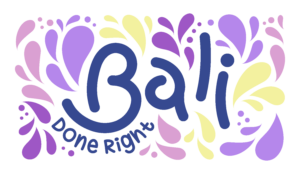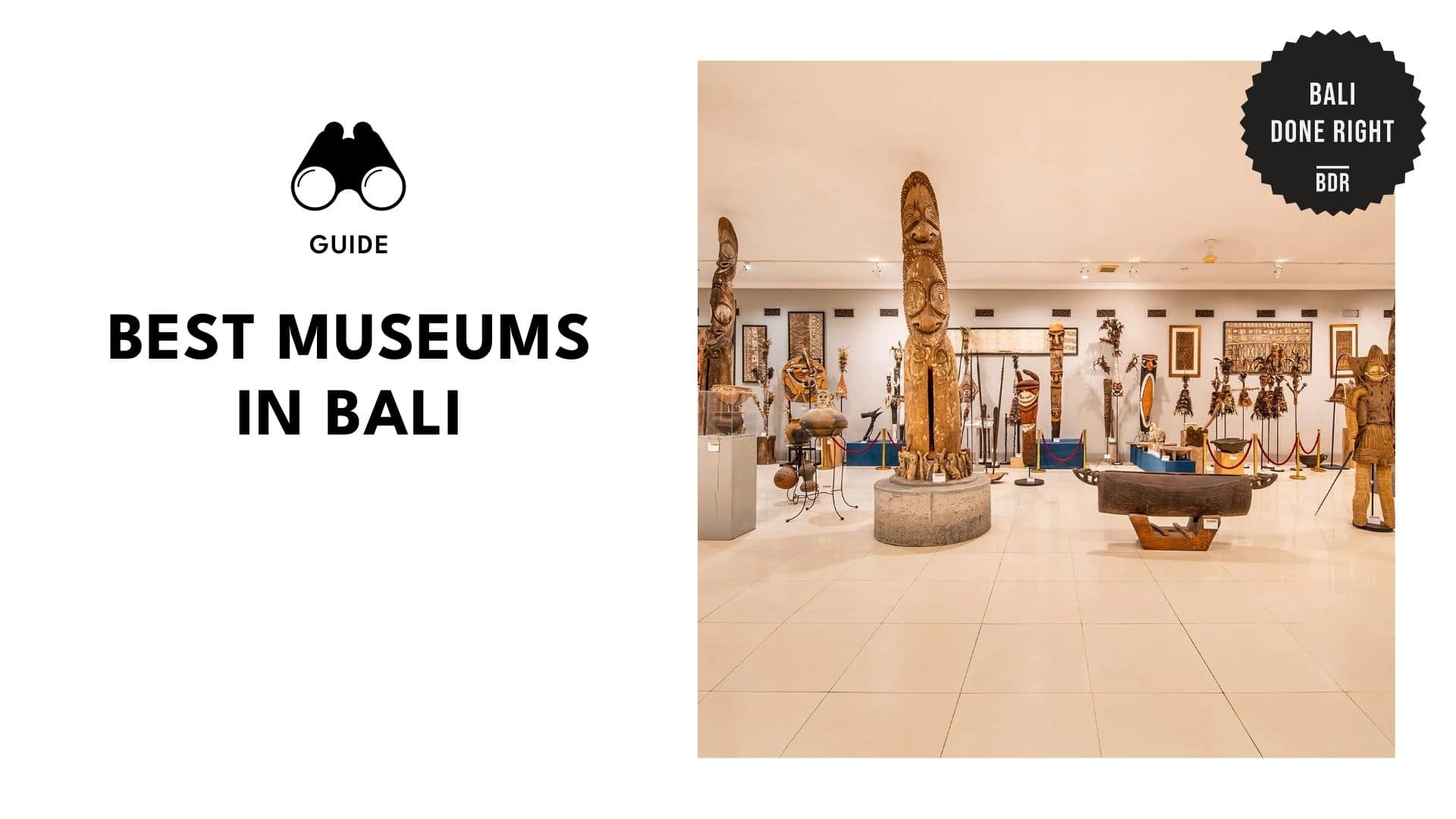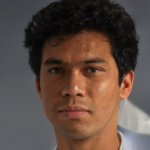Fall Headfirst Into Culture at These 10 Museums in Bali
Bali might be famous for its beaches and parties, but sometimes you just need a quiet spot where your brain works harder than sunscreen. Exploring museums is one of the smartest things to do when you need a break from the heat.
Fortunately, Bali’s museums will make you realise they’re anything but boring. You can expect colourful art, dramatic history, and plenty of moments where you’ll go, “Wait, I didn’t know that.”
It’s the kind of activity that makes you feel cultured and clever. Plus, you get a break from sweating. That’s not a bad trade-off for a couple of hours indoors.
1. Museum Pasifika
– Media credit: museumpasifika
Website: https://www.museum-pasifika.com/
Location: Complex Bali Tourism Development Corporation / ITDC Area Block P, Benoa, South Kuta, Badung Regency
Contact: +62361774935
Hours:
- Monday to Sunday: 10 AM – 6 PM
Pricing: $$
Tucked away in the heart of Nusa Dua, Museum Pasifika is one of Bali’s true hidden gems — a peaceful retreat that celebrates the vibrant artistry of the Asia-Pacific. Featuring over 600 artworks by 200 artists from 25 countries, the museum highlights pieces from Indonesia, Polynesia, Vanuatu, Papua New Guinea, and beyond.
The galleries are arranged by region rather than by time period, encouraging visitors to explore cross-cultural connections through art. Highlights include works and themes inspired by Paul Gauguin’s Polynesian period, which beautifully complement the museum’s Pasifika focus.
Guests can join batik and painting workshops, stroll through the lush gardens, and enjoy a relaxed, uncrowded atmosphere perfect for slow viewing. As Indonesia’s largest modern art museum dedicated to the Asia-Pacific, Museum Pasifika offers an enriching escape from the busier parts of Bali’s south.
| Pro Tip: If you’re visiting with kids, ask the staff for the free colouring activity sheet. They usually keep a stash for school groups, but they’ll happily give you one if you ask. It keeps younger visitors entertained while adults view the collections. |
2. Museum Puri Lukisan
– Media credit: museumpurilukisan
Website: https://www.purilukisanmuseum.com/index.html
Location: Ubud, Gianyar Regency
Contact: +62361971159
Hours:
- Monday to Sunday: 9 AM – 5 PM
Pricing: $$
This museum offers a deep dive into Balinese fine art throughout the 20th century, especially pieces from the Ubud and Batuan schools. Each pavilion is surrounded by manicured lotus ponds, which contrast beautifully with the wooden interiors.
We like how the museum’s older works are paired with clear wall texts that explain their symbolism, especially for non-Hindus. It’s one of the few museums in Bali that also documents the transition from classical to modern Balinese visual language.
There are rotating exhibitions throughout the year, often featuring collaborations with local schools. If you plan to take photos, note that flash is prohibited in certain rooms due to preservation policies.
Limited parking is available at the entrance, but walk-ins from the Ubud town centre are common. A few exhibits also include digital archives that can be scanned via QR code.
| Pro Tip: Bring your reusable water bottle. A free refill station is hidden behind the east pavilion near the toilets. It’s safe to drink and helps you avoid buying overpriced bottled water from nearby kiosks. |
3. SAKA Museum
– Media credit: sakamuseum
Website: https://www.sakamuseum.org/
Location: Jl. Karang Mas Sejahtera, Jimbaran, Kec. Kuta Sel., Kabupaten Badung
Contact: +62361702222
Hours:
- Saturday: 10 AM – 8 PM
- Sunday to Wednesday: 10 AM – 6 PM
Pricing: $$
The SAKA Museum utilizes immersive technology to showcase Balinese beliefs, particularly those related to time cycles, cosmic balance, and ritual objects. We think it’s a smart choice for first-timers who want to understand the cultural context before visiting temples.
The holographic exhibit on the Tri Hita Karana philosophy is one of the best educational segments on the island. Most visitors spend 30–45 minutes inside, especially when scanning the layered touchscreen displays.
Its location inside The Ayana Kempinski means it’s highly polished and open to non-hotel guests. There’s no printed brochure, but everything is explained in Bahasa Indonesia, English, and Japanese.
| Pro Tip: The interactive “Tumpek” calendar wall near the exit has an RFID scanner for mobile downloads. You can scan it for a free digital Balinese ceremonial calendar, available nowhere else. |
4. Setia Darma House of Mask and Puppets
– Media credit: binbin_white
Website: https://www.maskandpuppets.com/
Location: Jalan Tegal Bingin, Banjar Tengkulak Tengah, Kemenuh, Sukawati, Gianyar Regency
Contact: +62361977404
Hours:
- Monday to Sunday: 8 AM – 4 PM
Pricing: $$
This privately owned collection comprises over 7,000 traditional masks and puppets from Indonesia, Africa, and Europe. We were surprised at how well-maintained each joglo house is, and each one features a distinct lighting and arrangement style.
There are no formal display cases. Many pieces are suspended or posed on wooden stands, which creates a theatrical atmosphere. We appreciate that the staff allows visitors to take photos freely.
Some exhibits explain the spiritual function of the masks, which are still used in ceremonies. There’s also a section dedicated to contemporary puppet art made by Indonesian students.
If you visit mid-morning, you’ll hear birds chirping from the surrounding forested garden, which adds to the immersive feel. Donations are optional, but we suggest bringing cash if you want to contribute.
| Pro Tip: If you’re visiting as a group of 5 or more, you can request a private guided tour at no additional cost. Ask the front desk, and someone will walk you through key pieces with cultural context. |
5. Agung Rai Museum of Art (ARMA)
– Media credit: arma.bali
Website: https://www.armabali.com/museum/
Location: Jl. Raya Pengosekan Ubud, Ubud, Kecamatan Ubud, Kabupaten Gianyar
Contact: +62361976659
Hours:
- Monday to Sunday: 9 AM – 6 PM
Pricing: $$
ARMA combines gallery space, a cultural park, and a performance venue. Its collection includes traditional Kamasan-style paintings and international works by artists like Walter Spies.
We love how the exhibits are housed in high-ceilinged Balinese pavilions with excellent natural light. You’ll also spot temple fragments and sculptures scattered across the gardens, not confined to interior displays.
Beyond the art, the museum offers optional cultural workshops on gamelan, Balinese dance, and wood carving. The gardens also include rice paddies and traditional irrigation canals.
| Pro Tip: Use your museum ticket to access the cleanest free toilets in Ubud. They’re in the ARMA resort compound near the performance stage, and far cleaner than public ones in the town centre. |
6. The Blanco Renaissance Museum
– Media credit: blancomuseum
Website: https://blancomuseum.com/
Location: Jl. Raya Campuhan, Sayan, Kecamatan Ubud, Kabupaten Gianyar
Contact: +62361975502
Hours:
- Monday to Sunday: 9 AM – 5 PM
Pricing: $
Don Antonio Blanco’s estate showcases paintings, personal sketches, and memorabilia focusing on femininity and sensual forms. His flamboyant lifestyle is reflected in the ornate frames, signature swirls, and lavish interiors.
The rooftop terrace has a panoramic view of Campuhan Valley, while the aviary hosts tropical birds he once painted. Due to adult themes, some artworks are behind curtains and may not be suitable for younger guests.
The studio preservation was thoughtful: brushes, palettes, and unfinished works remain just as he left them. The building merges Balinese, Spanish, and Renaissance architectural styles.
| Pro Tip: Beware of the parrots near the entrance. They’re cute but trained to perch and sometimes nip, especially if you wear jewellery or dangling earrings. Stay hands-off unless the staff offers the bird to you directly. |
7. Neka Art Museum
– Media credit: jestem_gestem
Website: https://nekaartmuseum.com/
Location: G753+2F7, Jl. Raya Sanggingan Jl. Raya Campuhan, Campuhan, Kedewatan, Kecamatan Ubud, Kabupaten Gianyar
Contact: +6281338424036
Hours:
- Monday to Sunday: 9 AM – 5 PM
Pricing: $$
The Neka collection includes traditional wayang-style paintings, post-independence art, and a significant selection of black-and-white photography. It’s one of the few museums extensively documenting Bali’s artistic evolution from local to global.
We were especially impressed by the Kris Dagger gallery, which has historical notes and photos of the original owners. Most of the galleries are arranged thematically rather than by artist.
There are outdoor sculptures between buildings, so prepare for some walking.
However, drinking water isn’t sold on-site, so it’s best to bring your own. WiFi is available at the entrance, but the signal tends to drop inside the exhibit rooms.
| Pro Tip: There is no food or drink for sale on-site, but a local warung, Warung Pulau Kelapa, is just a 3-minute walk away. It’s affordable, scenic, and quieter than Ubud centre. |
8. Museum Rudana & Rudana Fine Art Gallery
– Media credit: museumrudana
Website: http://www.therudana.org/
Location: Jl. Cok Rai Pudak No.44, Peliatan, Kecamatan Ubud, Kabupaten Gianyar
Contact: +62361975779
Hours:
- Monday to Sunday: 9 AM – 5 PM
Pricing: $$
The museum features a curated mix of classical Balinese art, abstract expressionism, and spiritual sculpture across three stories. The building is oriented using the Balinese Tri Angga spatial philosophy, symbolising the lower, middle, and upper realms.
Elevators are available, but the central staircase offers better views of each floor’s signature pieces. We appreciated that the top floor was more meditative, with themes such as cosmic harmony and ancestral reverence.
Artworks for sale are displayed alongside the permanent collection, though labelled separately. Visitors often confuse the museum with the commercial gallery next door, but the staff are usually available to clarify entry points.
Some rooms have specific incense fragrances based on the Balinese lunar days, which are part of the spiritual experience.
| Pro Tip: There’s a sacred meditation room on the top floor, open only upon request. If you’re respectful and dressed appropriately, you can ask to enter for a few minutes of silent viewing. |
9. Ikat Gallery
– Media credit: ikatgallerybali
Website: https://www.ikatgallery.com/
Location: JL. Raya Kerobokan No. 40 Br. Taman Seminyak, Kerobokan Kelod, Kec. Kuta Utara, Kabupaten Badung
Contact: +62361732223
Hours:
- Monday to Saturday: 9 AM – 6 PM
Pricing: $$
This is both an exhibition space and textile showroom that houses authentic ikat, songket, and endek weaves from across the Indonesian archipelago. Each collection is grouped by island, with Sumba, Flores, and Kalimantan having strong representation.
We like that the textiles are displayed on rotating racks, allowing full viewing of pattern details. The gallery also sells certified heritage textiles with documentation on dye and thread origin. Some items are museum-grade and not for sale, clearly labelled for preservation.
They occasionally feature guest artisans doing live demos in the back workshop area. English-speaking staff are available to explain weaving techniques and dye sources.
| Pro Tip: Request to see the “Sumba ceremonial cloth archive” stored in climate-controlled drawers at the back. These textiles are not on display and are only shown upon request, typically to interior designers or textile scholars. |
10. Museum Geopark Batur
– Media credit: geoparkbatur
Website: https://ppsdm-geominerba.esdm.go.id/home/museum_gunung_api_batur
Location: Penelokan Main Rd, South Batur, Kintamani, Bangli Regency
Contact: +6236651088
Hours:
- Monday to Sunday: 8 AM – 4 PM
Pricing: $
This museum is part of the Batur UNESCO Global Geopark and highlights volcanic activity, tectonic processes, and disaster preparedness. Exhibits include rock samples, eruption timelines, and educational videos about Mount Batur.
Some zones utilize hands-on models and touchscreen maps to illustrate fault line movement. A few sections feature post-eruption photos and show how villages have adapted over the decades.
Many displays are in Bahasa only, but geological diagrams are easy to understand regardless of language.
| Pro Tip: There is no ATM or e-wallet support available at the ticket counter, so please bring enough small cash to cover the entrance and parking fees. The nearest ATM is over 2 km away, and the internet signal is spotty in this part of Kintamani. |


